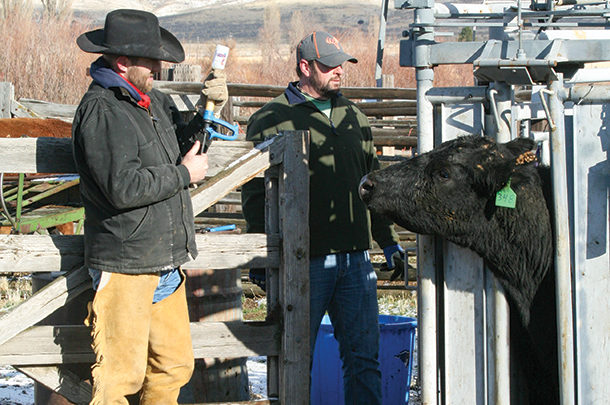Pregnancy loss is frustrating. We have waited a whole season for the cow or heifer to calve – only to find that she doesn’t calve or loses the calf near calving time. Cows that experience abortion should be separated from the herd to reduce the chances of spreading something that could be contagious. A little preparation and prevention can go a long way to avoiding pregnancy loss in cows. And that of course is important; after all, without any calves, we don’t get a paycheck.
Technically, pregnancy loss in cattle is divided into three categories: early embryonic loss (less than 45 days), abortion of the fetus (from 45 days until full term) and stillborn (may be born alive but fails to rise and nurse). While the outcome of loss at any stage is failure of the cow or heifer to produce a live calf or delayed rebreeding, determining when the loss occurred is important when trying to determine the cause because there are some risk factors that are more specific to each stage of pregnancy, while others can cause loss or abortion at any stage.
Pregnancy maintenance requires a healthy dam, properly functioning placental membranes and healthy fetus. If the health or function of any of these are compromised, then the pregnancy may be terminated. The list of things that can cause pregnancy loss is long, very long.
Most producers think of infectious causes (disease caused by an organism like a bacteria or virus) when they think of abortion, but other things like toxins, environment, genetic defects, physical trauma or even severe stress can also cause pregnancy loss or contribute to pregnancy loss. Some organisms like leptospirosis and listeria spp. can be found in the environment and often affect only one or very few animals. Viruses like bovine viral diarrhea (BVD) or bovine herpes virus (IBR), however, can be very contagious and require immediate intervention if they are found in the herd.
Prevention of pregnancy loss
Producers can’t protect every pregnancy, but many causes of pregnancy loss or abortion can be avoided with some simple common-sense practices.
- Good nutrition is essential – Healthy cattle on a balanced diet in good body condition generally don’t have problems with pregnancy loss. Testing forages for nitrates and avoiding feeding forages high in nitrates is also a good management practice. Proper storage of forages is also important. Spoiled hay or improperly ensiled forages can contain organisms that can cause abortion.
- Proper vaccination against many common infectious organisms – The commonly available vaccines don’t protect against all possible infectious causes but do stimulate immune protection against many of the common causes of abortion such as IBR, BVD, campylobacter (vibrio) and leptospirosis. Proper timing and handling of vaccine is important for vaccines to work as intended. Caution: Some vaccines can cause abortion if not given according to the label.
- Biosecurity plan – Minimizing exposure from introduced problems is critical. Introducing replacement cattle, including bulls, at the wrong time can also introduce organisms that cause abortion. Avoiding any additions until after cows have calved is the best bet, and making sure all new additions are free from infectious disease is critical.
- Maintaining a safe environment – Let’s face it, we can’t protect cows 24/7-365, but we can guard against common environmental and human-oriented risk factors. Provide shade or allow access to trees during times of severe heat stress, design cattle-friendly handling facilities and implement low-stress handling to avoid rough handling of pregnant cows, fence off areas of stagnant water, properly store all feeds, and control toxic plants.
Diagnosis of pregnancy loss
Sometimes producers have open cows at calving time and assume they aborted. However, unless cows were confirmed pregnant, we can’t be sure if the cow experienced abortion or just wasn’t bred. Obvious signs of abortion include presence of aborted fetus, placental membranes hanging from the vulva or blood-tinged discharge. Many times, producers don’t ever see the aborted fetus or other evidence a cow aborted.
Investigating the cause can be frustrating. In many cases, a definitive cause may not be found. However, collecting and preserving the right samples can improve the chances of finding a diagnosis. Thorough sample collection involves collecting samples from the aborted fetus and membranes, affected cow and other members of the herd both affected and normal. Sometimes an intact fetus is sufficient, but unless the toxin or organism that caused the abortion infected the fetus, it may look normal.
Some organisms only infect the placenta, so collecting samples from the placenta improves the chances of finding the cause. If possible, it is better to deliver the fetus and placenta to the lab intact, but if that isn’t possible, then it is important to collect the right samples. Resources are available to advise veterinarians on the best set of samples to collect and appropriate method of submission, but a call to the lab prior to collecting the samples can also help answer any questions.
Blood tests can be helpful, but interpreting the results can be tricky. Antibodies in the blood only indicate the animal was vaccinated or exposed to an organism. Measuring antibody levels (acute sample) at the time of the abortion and comparing the levels to other normal animals as well as comparing them to a second sample collected 30 days later (referred to as the convalescent sample) is most helpful to tell if the exposure occurred about the same time as the abortion. It is important to include the vaccination history, as vaccines cause antibody titers and it isn’t possible to differentiate vaccination and exposure antibody levels.
Though any loss isn’t wanted, it happens and one abortion may not be cause for alarm. It is, however, cause for increased attention. One case might be just an odd occurrence or the beginning of an outbreak requiring intervention. A conversation with your veterinarian or with a diagnostic lab professional can help determine whether tests are warranted. Collect all your herd management records, as these can be helpful in determining the best course of action.












